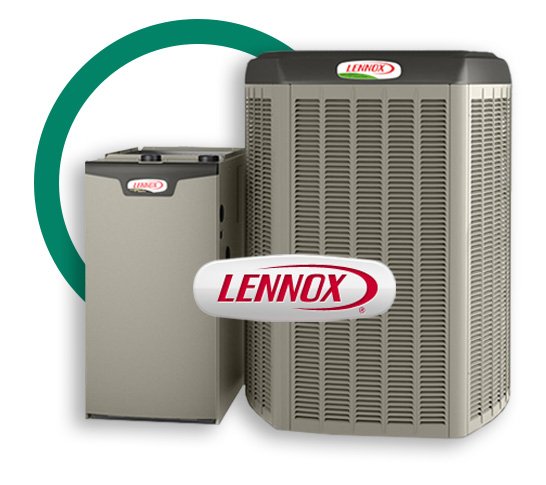8 Easy DIY Steps to Make Your AC Run at Maximum Efficiency
 When you consider that your heating and cooling bills account for about half of your energy expenses year round, it makes sense that a little maintenance can go a long way in making your system run more efficiently and saving you money. With that in mind, the team at Lancaster Brothers Heating and Cooling has put together this 8-Step DIY plan to help your system run at peak efficiency.
When you consider that your heating and cooling bills account for about half of your energy expenses year round, it makes sense that a little maintenance can go a long way in making your system run more efficiently and saving you money. With that in mind, the team at Lancaster Brothers Heating and Cooling has put together this 8-Step DIY plan to help your system run at peak efficiency.
Safety First!
Before you begin, turn off the power to the unit. Turn the condenser switch on the outside unit to the “off” position. Go to your breaker box and turn off the breaker to your furnace and AC. You don’t want it turning on while you have your hands near the fan blades!
Indoor AC Steps
1. Clean the evaporator coils
On many systems, these will be behind a door near the blower motor. It may even be sealed with foil tape. Open the cover and use a soft brush to dust off the coils. A paint brush or dust pan broom should work just fine. Spray the coil with coil cleaner, letting it drip into the drain pan. Afterwards, clean the drain pan with soap and hot water. Check the drain to make sure water is flowing freely. If it does, you can skip the next step.
2. Clean the evaporator drain tube
This tube is usually a 1-inch PVC pipe coming from the evaporator. It could be white or clear. Follow it to where it drains out. Attach the wet/dry vacuum to this end, sealing it with duct tape or with a rag. Remove the vacuum’s filter to avoid damaging it and turn the vacuum on for 2-3 minutes to clear out any blockage.
3. Change the air filter
This should be done once a month on average (though manufacturers’ recommendations may vary by unit). At the bare minimum, change it twice a year; once at the start of the cooling season and once at the start of the heating season.
4. Turn the power back on and let it go through a full cycle
If it’s not cooling like it used to, it’s time to call a pro.
Outdoor AC Steps
5. Clean out around your condenser
Make sure the unit is free from plants, sticks, dirt, mud, animal nests and any other foreign objects. Rake any ground-level debris away from the condenser and prune any branches or bushes away at least two feet.
6. Clean the condenser
Remove the grate over the fan and vacuum away any debris found inside. With a garden hose, spray the fins from the inside out. (Never use a pressure washer. The fins are very thin and can be easily damaged.)
7. Inspect the fins
They are very thin and bend easily. If you see damaged spots, straighten them gently with the butter knife or fin tool. Be careful not to damage the tubing within the fins.
8. Level the condenser
As soil settles, it’s not unusual for the condenser pad to lean or sink on one side. Using shims and a level, bring the condenser back to a level position.
Following these steps will keep your home’s indoor air cleaner, reduce allergy symptoms, and allow your system to work more efficiently, reducing energy costs.
Give Lancaster Brothers a call and we can check your AC to make sure it is running at peak efficiency. You can save even more by joining our Maintenance Club. To schedule a maintenance visit, please feel free to contact us online or call us at (913) 851-3399. If you need a new air conditioner, we can install a quality Lennox unit at great savings.
Chris Lancaster June 26th, 2017
Posted In: Cooling, Indoor Air Quality
The 16 Best Houseplants for Healthy Indoor Air & Eliminating Allergens
If you’re not an allergy sufferer, you may not understand the importance of having a place to go where you can breathe clean, fresh, allergen-free air. Springtime is hard on people with allergies. Sneezing, runny nose, that feeling that you want to claw your own eyes out because they itch so badly – we sympathize.
We have some good news for allergy sufferers. While you can’t control the outside air, or even the air at your place of work, you CAN control the air in your home. You sleep in that home at least eight hours every night, so you have the ability to breathe healthy, allergen-free air at least one third of your day. Read on to find out the three secrets to making your home a haven from allergens.
Why Is the Air in Your Home So Bad?
First, to understand why there is so much room for improvement in the typical home’s air quality, we must understand what causes it to be so bad to start with. While there are some well known causes for poor air quality, like car exhaust or carbon monoxide, many of the culprits behind inferior air are household products we use every day.
Air fresheners, pesticides, cosmetic products, types of glues, and even office equipment like printers or copiers can release particles into the air that can sabotage the quality. Not all of these kinds of pollutants will cause serious health damage, but some can cause lesser symptoms like fatigue, irritated eyes or skin, or coughing.
It’s important to remember that air moves through your home – sources of poor air quality in one room rarely stay in that room. However, it’s also worth noting that we like to seal our home up tightly to create more efficient heating and cooling. So, when the air in your home becomes polluted, it stays in the home. If you’re not sure about the air quality in your home, ask yourself some simple questions:
- Do you have leaking or standing water anywhere inside your home?
- Can you smell mold or mildew?
- Have you recently renovated any rooms (painted, installed carpeting, etc.)?
- Do you use solid fuels (like wood or coal) for heating or cooking?
If you answered yes, you may have some serious indoor air quality issues. These activities, and any others that release particles into the air you breathe, bring down the quality of that air. Most activities that leave a strong smell behind – painting, refinishing wood, grilling or smoking meat – are leaving particles in the air. Careful attention and ventilation are required to keep these activities from polluting the air in your home.
Make Your Home Your Sanctuary
While we are a heating and cooling company, we want you to know that we can help with allergies, too. At Lancaster Brothers, we offer whole-house air cleaners that remove dirt, dust, pet dander, mites, and other allergens from the air in your home. We recommend the Lennox PureAir purification system for allergy sufferers.
What’s Wrong with My Current Air Filter?
Most homes are heated by a traditional heating and cooling system, and with that system comes an air filter. Most of us are familiar with that 1” filter that you normally change once a month. You do realize you have to change that, right?
That 1” filter is designed to capture about 10% of what is flying around your home. Meaning, it really only captures the largest dust spores in the air and not much else. A larger 4” filter is a better option since it will collect about 80% of what is in the air. This type of filter is able to collect more of that dust and smaller particles as well. However, if you have allergy sufferers living in your home, there are contaminants that still remain in the air you breathe. You need a serious air filter.
Weapon #1 – The PureAir Air Purification System
The best option for clean air in your home is an electronic air cleaner. Indoor air contains three classes of contaminants that negatively affect indoor air quality. Many air cleaning systems available today only combat some of the irritants found inside your home. We choose to use this system because it is the only single indoor air quality system that is designed to address all three classes of indoor air contaminants:
- Airborne Particles – The PureAir system filters out more than 95% small, breathable particles such as dust, dirt, pollen, and allergens down to .3 microns
- Germs and Bacteria – The PureAir system combats 90% of airborne mold spores, bacteria, and viruses down to .01 micron
- Chemical Odors and Vapors – PureAir destroys household odors and chemical vapors from sources like pets, cleaning products, and cooking appliances
For allergy sufferers, this is the best type of air filtration to have in your home. Not only can it be installed on any existing furnace and air conditioner system, it will also provide the cleanest possible air to breathe in your own home.
Weapon #2 Follow These Tips for Allergy Sufferers
- Shower at Night – This helps remove any pollen and other allergens from your hair that would otherwise get transferred to your pillow…where you breathe every night
- Go Barefoot at Home – Removing your shoes helps keep from tracking allergens around your home and embedding them into the carpet
- Keep the House Closed Up Tight – It may be tempting to let the fresh air in, but allergy sufferers will pay for it, so don’t do it
- Change Your Filter on Your AC Often – Keep the air as clean as possible by replacing your air filter at least once a month
- Use the Re-circulate on Your Vehicle’s AC – When driving in your car, you can reduce the amount of allergens you breathe by recirculating the existing air, rather than letting fresh air in
- Lower the Humidity in Your Home – A humidity level of less than 60% will discourage spores from mold growth
- Pay Attention to the Pollen Count Outside – If the pollen, ragweed, mold, etc. count is high, it’s best to limit your outdoor activities that day
Weapon # 3 Houseplants
One other way to make your home a haven from allergens is to let nature remove them from the air for you. One of the best additions allergy sufferers can add to their homes is houseplants. Plants remove toxins from the air 24 hours a day just by living there!
NASA (National Aeronautics and Space Administration, yes, that NASA) did a Clean Air Study in 1989, in an effort to find ways to clean air in space stations. That study revealed a number of plants that not only absorb carbon dioxide and release oxygen (as all plants do), but also remove other toxic agents like benzene, formaldehyde, and trichloroethylene from the air. Their recommendation efficient air cleaning is to use at least one plant per 100 square feet of space. Here is the list of the 16 best plants you can add to remove toxins from the air.
Chinese Evergreen (Aglaonema Crispum ‘Deborah’)
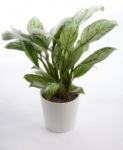
This plant likes low light and humid air. Mist the leaves lightly to keep them from turning brown.
- Removes: benzene and formaldehyde
- Warning: Toxic to dogs and cats
English Ivy (Hedera helix)

This climbing vine does well in low light environments and prefers moist soil and occasional misting.
- Removes: benzene, formaldehyde, trichloroethylene, xylene, and toluene
- Warning: Toxic to dogs and cats
Peace Lily (Spathiphyllum)
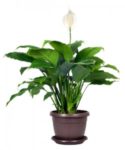
This plant can grow in low light and blooms year round. Weekly watering is required, but it lets you know when it’s thirsty by wilting, but quickly recovering when watered. It has a high transpiration rate that will humidify your air.
- Removes: benzene, formaldehyde, trichloroethylene, xylene, and toluene
- Warning: Toxic to dogs and cats
Broadleaf Lady Palm (Rhapis excelsa)
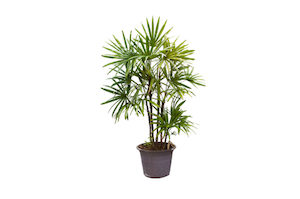
Palm trees are relatively easy to care for and add a tropical feel to any home. They prefer cooler temperatures (60-75 degrees). Dwarf date palm, bamboo palm, areca palm, and parlor palm are all good air cleaners in the palm family.
- Removes: formaldehyde, xylene, toluene, ammonia, and acetone
- Non toxic to dogs & cats
Boston Fern (Nephrolepis exaltata)
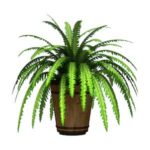
The Boston fern is considered one of the most efficient air purifiers, but can be temperamental requiring constant moisture. They require weekly feeding in the warmer seasons when they’re growing, monthly during the winter, and they like to be watered and misted regularly. The Kimberley Queen is a larger fern with broader leaves that fares better in drier air. It’s a great natural humidifier.
- Removes: formaldehyde, xylene, and toluene
- Non toxic to dogs & cats
Snake Plant (Sansevieria trifasciata)

This plant’s common name is mother-in-law’s tongue, named for its long, sharp leaves. It thrives in low light and humid conditions making it perfect for placement in the bathroom.
- Removes: benzene, formaldehyde, trichloroethylene, xylene, and toluene.
- Warning: Toxic to dogs and cats
Red-Edged Dracaena (Dracaena marginata)
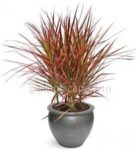
This slow-growing shrub has purple-red edges on its narrow leaves. It can reach up to 15 feet in height.
- Removes: benzene, formaldehyde, trichloroethylene, xylene, and toluene
- Warning: Toxic to dogs and cats
Warneck Dracaena (Dracaena deremensis ‘Warneckei’)
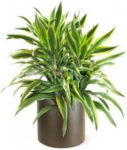
This shrub is also slow growing but features white stripes along the leaf edges and requires even less sunlight than the red-edged variety.
- Removes: benzene, formaldehyde, and trichloroethylene
- Warning: Toxic to dogs and cats
Aloe (Aloe vera)
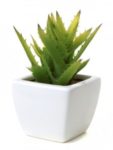
Aloe is easy to grow, and loves the sun. Besides cleaning the air, the gel inside the aloe plant helps heal cuts and burns including sunburn.
- Removes: benzene and formaldehyde
- Warning: toxic to dogs and cats and dogs
Barberton Daisy (Gerbera jamesonii)
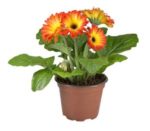
Gerberas (sometimes called gerber daisies) like well-drained soil, a little misting a couple of times a week, and at least six hours of sunlight a day. Brightly colored cut blooms can last as long as two weeks. Bonus – their happy, colorful flowers stay fresh for a couple of weeks when cut.
- Removes: benzene, formaldehyde, and trichloroethylene
- *Non-toxic to dogs and cats
Chrysanthemum (Chrysantheium morifolium)

Mums, as they’re commonly called, love bright, direct sunlight. Choose a floral variety, not a garden variety for inside use.
- Removes: benzene, formaldehyde, trichloroethylene, xylene, toluene, and ammonia.
- Warning: Toxic to dogs and cats
Weeping Fig (Ficus benjamina)
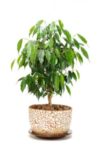
Ficus trees can be finicky. They prefer bright, but indirect light and don’t like large fluctuations in light or temperature. Once you get the light conditions and watering schedule right, they last a long time.
- Removes: formaldehyde, xylene and toluene
- Warning: Toxic to dogs and cats
Heartleaf Philodendron (Philodendron cordatum)
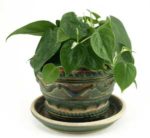
Heartleaf philodendron are very low-maintenance plants. They thrive with indirect light and very little maintenance. Like other vines, it can trail from a hanging container or can be trained to climb trellis.
- Removes: formaldehyde
- Warning: Toxic to dogs and cats
Rubber Plants (Ficus elastica)
Tolerates very little sun (the less sun, the slower the growth) and is aesthetically pleasing.
- Removes: formaldehyde
- Non-toxic to dogs and cats
Janet Craig (Dracaena deremensis)
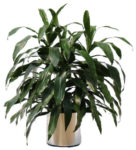
Janet Craigs will also tolerate very little sun, but are hardier than the rubber plant and will survive more abuse and neglect than the rubber tree.
- Removes: formaldehyde
- Warning: Toxic to dogs and cats
These beautiful additions can allow you to experience the difference of a home free from allergy inducing particles. If you know someone who suffers from allergies, share this blog with them to let them know they have options!
Want more information? Call the professionals at Lancaster Brothers Heating & Cooling at (913) 851-3399 or send us your questions at tina@lancasterbrothers.com today!
Chris Lancaster March 23rd, 2017
Posted In: Indoor Air Quality

